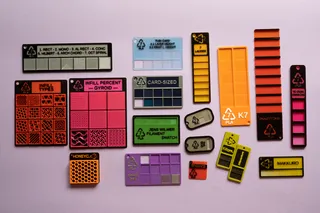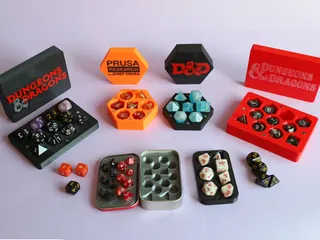Threaded 4-nozzle box
Description
PDFNozzles are screwed in the box, which also has tabs for good closing and notches in the lid to help with opening. The clearance of the thread is somewhat tight - enough to allow for a bit of miscalibration in the printer and printing artifacts, but making a tight fit anyway (see below). There are versions with the nozzle diameter numbers and printing materials (recycling symbols) in the base and lid, as well as nozzle material texts in the lid, and "blank" ones if you don't want them. Lid texts have two different orientations to choose from.
If you happen to have the full 7-nozzle set or “fun pack”, check the hexagonal 7-nozzle box.
The metric thread profile doesn't fare too well with 3D printing (too steep an overhang, and then there's the seams), so before putting the nozzles it's better if you "ream" or "clean" the threads with an M6 screw or, ideally a tap and die set (you can go straight ahead to the finest thread tap). With the thread cleared, you can screw and unscrew the nozzles with just your fingers.
Note that the 4-nozzle box can fit in the 7-nozzle box holders, and vice versa. The holders fit into the top z-axis hex holes of the MK3; the version with two pillars has a better fit, the one with one pillar is sleeker but may wiggle a bit (but won't fall even with the printer at full infill!); you may adjust the extrusion multiplier for a tighter fit.
The insert options for the lids don't require an MMU unit; they're designed to be printed with the "Print on print" technique. Just print the insert, remove brim and purge line, and print the lid on it; the negative text in the lid has a bit of clearance to ensure a nice fitting. Make sure that you're printing insert and lid in the same coordinates; you can put them both in PrusaSlicer and set one and the other as "printable" or "non-printable" before exporting to gcode.
BTW, the font in size labels and inserts is a Hershey sans; if you've seen PCBs, you'll be already familiar with it. Using a "stroke" font instead of an OpenType/ True Type one helps ensure the font definition. Note that the specimens were printed with a 0.6 nozzle - not what you'd expect to be used with thin details!
Tags
Model origin
The author remixed this model.





